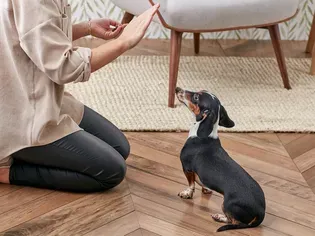How to Train Your Dog to Stay
Updated on 04/26/24

Master the Art of Dog Training: A Comprehensive Guide to Teaching Your Canine Companion the "Stay" Command
Bonding with your beloved canine is an extraordinary journey that requires patience, love, and effective communication. Teaching your furry friend the "stay" command is a cornerstone of this connection, empowering you to control their behavior in various situations and ensure their safety.
This comprehensive guide will delve into the intricacies of training your dog to stay, providing step-by-step instructions, proven techniques, and real-life examples to guide you through this rewarding process.
Understanding the "Stay" Command
The "stay" command is a fundamental cue that teaches your dog to remain in a specific position, even when distractions arise. It's more than just a trick; it's a practical skill that enhances your dog's obedience, promotes safety, and strengthens your bond.
Prerequisites for Success
Before embarking on this training adventure, ensure your dog possesses the following prerequisites:
* Basic obedience training: Your dog should understand commands like "sit," "come," and "leave it."
* High-value treats: Identify treats that your dog finds irresistible, as these will serve as powerful motivators.
* Patience and consistency: Remember that training takes time and repetition. Stay patient throughout the process and maintain consistency in your commands.
Step-by-Step Training Guide
1. Introduce the Concept
Begin by holding a treat in front of your dog's nose and saying "stay" in a clear, firm voice. As your dog maintains eye contact with you, slowly start to move your hand back slightly, keeping the treat in front of their nose. If they stay put, reward them immediately with the treat and praise.
2. Increase Distance and Duration
As your dog develops proficiency, gradually increase the distance between you and them during the "stay" command. Start with a few steps and gradually increase the distance as they progress. Similarly, extend the duration of the "stay" from a few seconds to several minutes.
3. Introduce Distractions
Once your dog has mastered staying in place without distractions, start introducing low-level distractions. Place a toy or treat on the floor next to them and give the "stay" command. If they stay in position, reward them appropriately. Gradually increase the intensity of distractions, like having another person or dog present, to test their focus.
4. Practice in Different Environments
Take your training sessions outside or to different rooms within your home to accustom your dog to staying in various environments. This ensures they can execute the command regardless of the surroundings.
5. Proof the Command
Once your dog can reliably perform the "stay" command in different situations, you need to "proof" it by challenging them with more significant distractions. Have them stay in place while you walk around, call their name, or engage in other activities. If they break the "stay," don't get discouraged; simply start practicing again until they achieve consistency.
Examples of Effective Training
* Training Buddy's "Stay": Buddy is a playful canine who struggles to control his excitement when out on walks. To train Buddy the "stay" command, start by practicing in a controlled environment, like your living room. Gradually increase the distance and duration of the "stay" and introduce distractions like a toy or other people. Once he's mastered it indoors, take your training sessions to the park or other outdoor areas, ensuring Buddy maintains his focus amidst the hustle and bustle.
* Teaching Luna to "Stay" in the Car: Luna is a loyal companion who loves car rides, but her tendency to jump out the moment the car stops can be dangerous. To teach Luna the "stay" command in the car, start by having her stay in the car with the engine off. Gradually increase the time she spends staying in the car and reward her consistently. Once she's comfortable staying in place, practice the command with the engine running and the car parked. Slowly progress to practicing the "stay" command while driving around, rewarding Luna for her obedience.
Benefits of Teaching Your Dog to "Stay"
* Enhanced Safety: The "stay" command provides your dog with self-control in dangerous situations, such as preventing them from running into traffic or approaching strangers.
* Improved Obedience: A well-trained dog that responds reliably to the "stay" command will exhibit better overall obedience, making walks, grooming, and other interactions a breeze.
* Stronger Bond: The act of training and working together strengthens the bond between you and your furry companion, fostering mutual respect and understanding.
* Practicality: The "stay" command is an incredibly useful skill that can be applied to various everyday situations, such as keeping your dog calm in crowded areas or teaching them to wait patiently for food or treats.
Conclusion
Teaching your dog to "stay" is an empowering endeavor that enriches your relationship, enhances their safety, and fosters their obedience. By following the step-by-step instructions, incorporating proven techniques, and tailoring the training to your dog's specific needs, you can successfully train your furry companion to master this invaluable command. Remember to stay patient, consistent, and reward their progress, and you'll soon enjoy a dog who responds reliably to the "stay" command, bringing peace of mind and joy to both of you.
Explore More Pets

Basic Training
Puppy and Baby Introductions

Working Dog Breeds
All About Search and Rescue Dogs

Dog Treatments
Puppy Vaginitis: Signs, Causes and Treatment

Dog Adoption
After More Than 1,200 Days in the Shelter, Coco Goes Home

Basic Training
How to Train Your Puppy to Go on Potty Pads

Hybrid Dog Breeds
The Difference Between a Mutt, Mixed Breed, or Designer Dog?

Dog Treatments
Nail Problems in Dogs

Puppies
7 Reasons Why Two Dogs Are Better Than One